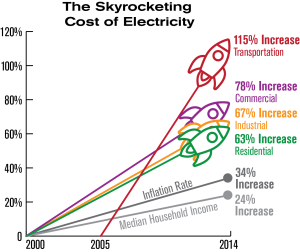Technology to utilize the forces of nature for doing work to provide human desires is as recent because of the initial watercraft. however, attention swung aloof from renewable sources because the age-progressed on the premise of the targeted energy fast up in fossil fuels. Power to Choose was combined with the increasing use of reticulated electricity supported fossil fuels and also the importance of transportable high-density energy sources for transport – the time of oil. As electricity demand escalated, with provide relying for the most part on fossil fuels and some hydropower then atomic energy, considerations arose concerning CO2 emissions contributory to potential warming. Attention once more turned to the massive sources of energy billowing around the U.S.A. in nature – sun, wind, and seas above all.

There was ne’er any doubt concerning the magnitude of those, the challenge was forever in harnessing them thus on meet demand. Today we tend to square measure well advanced in meeting that challenge, whereas additionally testing the sensible limits of doing thus from wind and star (variable renewable energy, VRE). The comparatively dilute nature of wind and star means that harnessing them is incredibly materials-intensive – again and again, that from energy-dense sources. Wind turbines have developed greatly in recent decades, star electrical phenomenon technology is way additional economical, and their square measure improved prospects of harnessing the energy in tides and waves. star thermal technologies above all (with some heat storage) have nice potential in sunny climates. With government encouragement to utilize wind and star technologies, their prices have return down and square measure currently within the same league per kilowatt-hour because of the inflated prices of fuel technologies, particularly with probably carbon emission charges on electricity generation from them.
However, the variability of wind and alternative energy doesn’t correspond with most demand, and as substantial capability has been in-built many countries in response to government incentives, the occasional large output from these sources creates major issues in maintaining the reliableness and economic viability of the complete system. there’s a replacement target system prices associated with achieving reliable provide to satisfy demand. In the following text, the levelised value of electricity (LCOE) is employed to point to the common value per unit of electricity generated at the particular plant, permitting the recovery of all prices over the life of the plant.
It includes capital, financing, operation and maintenance, fuel (if any), and decommissioning. Another relevant metric is energy come on energy invested with (EROI). this can be not quoted for specific comes, however, is that the subject of additional general studies. EROI is that the magnitude relation of the energy delivered by a method to the energy used directly and indirectly in this method, and is a component of lifecycle analysis (LCA). associate degree EROI of concerning seven is taken into account break-even economically for developed countries.
The U.S.A. average EROI across all generating technologies is concerning forty. the most important revealed study on EROI, by Weissbach et al (2013) showed: “Nuclear, hydro, coal, and fossil fuel power systems (in this order) square measure one order of magnitude more practical than photovoltaics and wind generation.” This raises questions about the property of wind and star PV that haven’t nonetheless been self-addressed in national energy policies.
The World Energy Outlook 2016 (WEO2016) builds the points that VRE have 5 technical properties that make them distinct from additional ancient sorts of power generation. First, their most output fluctuates in line with the time period availableness of wind and daylight. Second, such fluctuations may be expected accurately solely a couple of hours to days before. Third, they’re non-synchronous and use devices called power converters to attach to the grid (this may be relevant in terms of a way to make sure the stability of power systems). Fourth, they’re additional standard and may be deployed in a very rather more distributed fashion.

